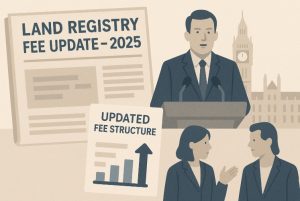Understanding land registry fees is essential when dealing with property transactions in the UK. In 2025, HM Land Registry continues to apply Scale 2 fees to specific non-monetary dealings, including gifts, assents, and certain mortgage registrations.
Knowing when and how these fees apply can prevent costly mistakes and streamline the registration process.
This guide explores the updated Scale 2 land registry fees, offering clarity for conveyancers, property professionals, and anyone managing title transfers without direct payment.
What Are Scale 2 Land Registry Fees and How Do They Work?

Scale 2 land registry fees are applied to specific types of property transactions where monetary consideration is not present or where the transaction involves a mortgage or trust-related process. These fees are part of HM Land Registry’s pricing structure and typically apply in cases where:
- A property is transferred by gift
- A transfer follows a divorce or civil partnership dissolution
- An individual is appointed as a trustee
- A mortgage or charge is being registered
These fees differ from Scale 1 fees, which are used for typical sales and leases involving a purchase price. Scale 2 fees are based on the value of the property or the charge, often taking into account any outstanding mortgages or liabilities.
The method of application also influences the amount payable. Online applications made via the HM Land Registry portal or Business Gateway are generally cheaper than those submitted by post.
When calculating the fee for a Scale 2 application, the value is assessed after deducting any outstanding charge or mortgage. If a mortgage exists and remains unpaid at the time of application, it reduces the value for fee purposes.
How Are Land Registry Fees Calculated in 2025?
The calculation for Scale 2 fees in 2025 is based on tiers determined by the value of the transaction.
There are three primary fee bands depending on how the application is submitted: by post, through the portal for the whole of a registered title, or through the portal for part of a registered title.
Scale 2 Land Registry Fee Table for 2025
| Transaction Value | By Post | Online Portal (Whole Title) | Online Portal (Part Title) |
| £0 to £100,000 | £45 | £20 | £45 |
| £100,001 to £200,000 | £70 | £30 | £70 |
| £200,001 to £500,000 | £100 | £45 | £100 |
| £500,001 to £1,000,000 | £145 | £65 | £145 |
| £1,000,001 and above | £305 | £140 | £305 |
Key points in calculating fees:
- If a mortgage remains on the property at the time of transfer and is not repaid, its amount is deducted from the value
- If the property is transferred to joint owners, only the value of the share transferred is considered
- The portal-based method results in significantly lower fees in most cases
What Transactions Qualify for Scale 2 Fees?
Transactions that fall under the Scale 2 fee structure usually involve no exchange of money or represent internal ownership adjustments. These include:
- Gifts of property with no payment
- Property transfers through court orders in divorce proceedings
- Probate transfers to beneficiaries via assent
- Registration of a mortgage when not linked to a purchase
- Transfers of registered charges or trusts
Some examples:
- A parent gifts a house worth £200,000 to a child: Scale 2 applies
- A spouse transfers property following a divorce court order: Scale 2 applies
- An executor assents a house to a beneficiary after probate: Scale 2 applies
- A mortgage for £150,000 is registered on an existing property: Scale 2 applies, based on loan value
These transactions focus more on the underlying value and mortgage structure rather than sale price.
How Do Scale 2 Fees Compare with Scale 1 Fees?

Understanding the distinction between Scale 1 and Scale 2 land registry fees is essential for accurately calculating the cost of property registration and avoiding delays in the process.
Both scales are used by HM Land Registry to determine fees based on the type and nature of the transaction, but they are applied in very different contexts.
Overview of Scale 1 Fees
Scale 1 fees are primarily applied to transactions involving monetary consideration. These include:
- Sales and purchases of property
- Leases and surrenders for value
- First registrations following a sale
- Registrations of leasehold interests
- Transfers involving payment, including those made with foreign currency or company shares
In all Scale 1 transactions, the fee is calculated based on the VAT-inclusive consideration or the rent in lease-related matters.
If a lease is granted, the fee is assessed on the sum of the premium plus the rent (or just the rent if no premium exists). Additionally, where a transaction triggers first registration, reduced fees may apply for voluntary applications.
The use of HM Land Registry’s online portal or Business Gateway offers significant cost savings, with reductions of up to 55% compared to postal applications.
Scale 1 Fee Table (2025)
| Value or Amount | By Post | Online (Whole of Title) | Online (Part of Title) | Voluntary First Registration |
| £0 to £80,000 | £45 | £20 | £45 | £30 |
| £80,001 to £100,000 | £95 | £40 | £95 | £70 |
| £100,001 to £200,000 | £230 | £100 | £230 | £170 |
| £200,001 to £500,000 | £330 | £150 | £330 | £250 |
| £500,001 to £1,000,000 | £655 | £295 | £655 | £495 |
| Over £1,000,001 | £1,105 | £500 | £1,105 | £830 |
Examples of Scale 1 transactions:
- A buyer purchases a house for £575,000 and pays a fee based on the purchase price.
- A commercial property bought for £900,000 plus £180,000 VAT is assessed on the full £1,080,000.
- A lease of a commercial property is registered with a rent of £150,000 over the first 5 years and no premium the rent becomes the basis for fee calculation.
For mixed cases (registered and unregistered land), separate applications and separate fees are required. Fees may also be apportioned if only part of the land is registered.
If a transaction qualifies for voluntary first registration (e.g. a property is registered without a prior compulsory requirement), a 25% discount applies to the standard Scale 1 fee. However, this doesn’t apply to rentcharges, franchises, or profits.
Overview of Scale 2 Fees
Scale 2 fees are applied when no monetary consideration is involved in the transaction. These situations include:
- Property gifts
- Transfers following death (assents)
- Transfers between trustees
- Registration of mortgages not related to a purchase
- Transfers ordered by a court under family law legislation
- Transfers involving appointment or retirement of trustees
In Scale 2 cases, the fee is usually calculated based on the value of the property, minus any outstanding mortgage or continuing charge.
Where the transaction involves only a share of the property, the fee is based on the value of the share being transferred.
Applications submitted through the Business Gateway or online portal also attract reduced fees under Scale 2 when the transaction involves the whole of a registered title. However, no reduced fee applies if the transaction relates to part of a registered title.
Scale 2 Fee Table (2025)
| Value or Amount | By Post | Online (Whole of Title) | Online (Part or Other) |
| £0 to £100,000 | £45 | £20 | £45 |
| £100,001 to £200,000 | £70 | £30 | £70 |
| £200,001 to £500,000 | £100 | £45 | £100 |
| £500,001 to £1,000,000 | £145 | £65 | £145 |
| Over £1,000,001 | £305 | £140 | £305 |
Examples of Scale 2 transactions:
- A property is gifted from a parent to a child with no payment involved.
- A house worth £200,000 is transferred to a beneficiary following probate.
- A spouse transfers their 50% share in a home to the other spouse after a divorce, with or without an accompanying court order.
- A property with an existing £100,000 mortgage is gifted to a relative; the fee is calculated on the net value after deducting the mortgage.
Where a transaction is subject to both a mortgage and a transfer of share, calculations become more complex. HM Land Registry requires clear evidence of the outstanding mortgage amount and the share being transferred to determine the applicable fee.
Key Comparisons Between Scale 1 and Scale 2
| Criteria | Scale 1 | Scale 2 |
| Type of Transaction | Sales, leases, surrenders involving money | Gifts, assents, mortgages, trustee changes |
| Fee Basis | VAT-inclusive consideration or rent | Value of property/share minus outstanding loans |
| Applies to First Registrations | Yes | No (except indirectly via trustee appointments) |
| Reduced Fees (Portal Use) | Yes (up to 55%) | Yes (for whole titles only) |
| Typical for Probate Transfers | No | Yes |
| Fee Assessment in Mortgage Cases | On full purchase price including VAT | On net value (property value minus debt) |
| Use in Divorce or Civil Partnership Orders | No | Yes |
| Leasehold Transactions | Yes | Rare (only certain surrender scenarios) |
Important Observations
- Scale 1 is the default for any transaction involving a purchase, even if the payment is in a foreign currency or equity.
- Scale 2 is typically used for family-related transfers, inheritance-based changes, and non-sale mortgage registrations.
- In some cases, multiple applications are needed, especially where land is both registered and unregistered, or if the transfer involves multiple parties.
Even though both fee scales use value as a basis, Scale 1 fees are significantly higher due to the assumption that there is a monetary benefit involved.
Scale 2 aims to reflect a more administrative or trust-based transfer process, thus attracting a lower rate.
By clearly identifying which scale applies to a transaction and choosing the correct application method, applicants can not only ensure compliance with HM Land Registry requirements but also potentially save hundreds of pounds in fees.
Why Have Land Registry Fees Changed in 2025?

The structure of land registry fees is reviewed periodically by HM Land Registry. The 2025 adjustments reflect:
- Efforts to encourage digital application methods
- Administrative costs associated with manual applications
- Inflationary pressures affecting government services
The changes for 2025 are minimal in terms of actual figures, but the focus on portal-based submissions continues to offer cost advantages. Those using postal methods will see consistently higher fees compared to electronic submissions.
Can You Reduce or Avoid Paying Scale 2 Fees?
In certain situations, it’s possible to benefit from reduced fees or exemptions. These opportunities depend on the nature of the transaction and the submission method.
You can reduce Scale 2 fees by:
- Using the Land Registry online portal or Business Gateway
- Ensuring that mortgage registrations are submitted with transfers when eligible to combine under one fee
Exemptions apply for:
- Transfers where a scale fee is already being paid under a different category
- Discharges of registered mortgages
- Death of a registered proprietor (application to update records only)
- Transfers submitted alongside a compulsory first registration
Not all transactions are eligible for reductions. Transfers involving a partial interest, such as gifting a share of a property or adding/removing trustees, often still require a full fee under Scale 2.
Where Can You Check the Latest HM Land Registry Fee Scales?
HM Land Registry publishes its full fee structure and guidance on the official GOV.UK website. Property professionals and individuals can access:
- A downloadable PDF fee scale document
- Interactive fee calculator tools
- Practice guides explaining transaction-specific scenarios
For digital users, legal software tools and conveyancing platforms offer built-in calculators based on current HM Land Registry rates. These systems help reduce errors in fee assessment and improve turnaround times.
What Should Conveyancers and Property Buyers Know About Scale 2 in 2025?

Professionals handling land registration need to be well-versed in the distinctions between Scale 1 and Scale 2, especially since errors in fee payments can cause delays.
Points for conveyancers to remember:
- Confirm whether the transaction involves payment or not
- Check for ongoing or new mortgages and factor these into the value calculation
- Ensure the correct method of application is chosen (postal vs portal)
- Use HM Land Registry guidance for complex ownership scenarios (e.g. trusts, joint tenants, legal guardianship)
- Maintain awareness of fixed fees applicable for other services like restrictions, notices, or adverse possession claims
In many cases, a misclassified transaction can be corrected, but it may delay the registration process and incur additional administrative steps.
Conclusion
Understanding Scale 2 land registry fees is essential for property professionals and private individuals involved in non-monetary transfers, trust restructures, or mortgage registrations. The 2025 updates reinforce the value of digital submissions and the importance of understanding fee categorisations.
Whether you’re registering a transfer of equity, executing a trust deed, or handling a mortgage transaction, accurate fee assessment using Scale 2 criteria ensures compliance and avoids unnecessary delays.
FAQs
What is the difference between Scale 1 and Scale 2 land registry fees?
Scale 1 applies to property sales and lease registrations involving payment, while Scale 2 covers non-monetary transactions such as gifts or mortgage registrations.
How often do HM Land Registry fees change?
Fees are reviewed periodically and may change due to inflation, operational updates, or government policy shifts.
Can I calculate Scale 2 fees using an online tool?
Yes, various online tools and legal software platforms help estimate land registry fees based on transaction type and value.
Are conveyancing fees separate from land registry fees?
Yes, conveyancing fees are charged by legal professionals and are separate from the statutory fees paid to HM Land Registry.
What happens if I underpay a land registry fee?
The application may be delayed or rejected until the correct fee is paid, potentially impacting transaction timelines.
Do first-time buyers ever pay Scale 2 fees?
Only if the transaction qualifies for example, if they’re gifted a property or transferring equity without paying money.
Are land registry fees in Scotland and Northern Ireland the same?
No, land registry systems and fee structures differ in Scotland and Northern Ireland. This blog applies to England and Wales only.





